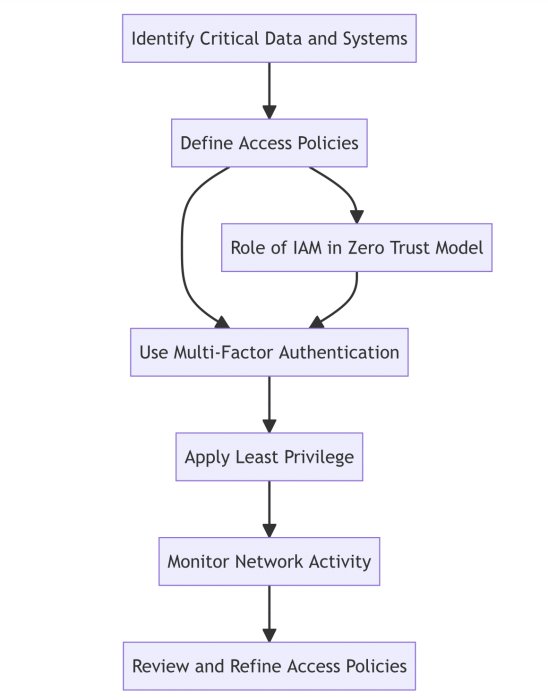Zero Trust Security Model
Implementing a Zero-Trust Security Model for Effective Data Protection
The zero-trust model is an information security framework that has become increasingly popular in recent years. It refers to the principle of not trusting anything inside or outside of the network perimeter by default. Instead, it requires verification of every user and device that tries to access the network. This approach helps to reduce the attack surface and improve overall security posture.
Origins of Zero Trust
The term zero trust was first coined in 2010 by Forrester Research, but the concept can be traced back to the BeyondCorp project developed by Google. The project aimed to address the challenges of traditional perimeter-based security models, where access to resources was restricted based on whether a user was within the corporate network or not. BeyondCorp sought to move away from this model and instead focus on identity-based access controls, allowing employees to access resources from any device, anywhere in the world, as long as they could prove their identity.
How to Implement Zero Trust Model?
Implementing a zero-trust model requires a systematic approach. Here are the key steps involved:
- Identify critical data and systems that need to be protected.
- Define the access policies for each user and device.
- Use multi-factor authentication (MFA) to verify user and device identity.
- Apply the principle of least privilege, which means granting users the minimum level of access necessary to perform their job functions.
- Monitor network activity in real-time to identify potential threats.
- Continuously review and refine access policies based on user and device behavior.

What are the Key Components of Zero Trust?
- Identity and Access Management (IAM): This involves verifying the identity of users and devices attempting to access resources, and providing access only to those with the appropriate level of authorization (detailed hereafter).
- Network Segmentation: This involves dividing the network into smaller segments, each with its own security controls and access policies. This reduces the risk of lateral movement by attackers in the event that one segment is breached.
- Endpoint Security: This involves securing all endpoints, including laptops, desktops, servers, and mobile devices, with appropriate security controls such as firewalls, antivirus software, and intrusion detection and prevention systems.
- Least Privilege: This means providing users with the minimum level of access required to perform their jobs, and restricting access to sensitive resources to only those who need it.
- Continuous Monitoring: Monitoring network activity in real-time to detect and respond to security threats as they arise.
The central role of Identity and Access Management (IAM) in Zero Trust Model
Identity and access management (IAM) plays a crucial role in the zero-trust model. IAM is the process of managing user identities and their access to resources. IAM ensures that only authorized users and devices can access critical systems and data. In a zero-trust model, IAM is used to verify user and device identity before granting access. This can be achieved through MFA, biometric authentication, or other forms of identity verification.
In conclusion, the zero-trust model is an effective approach to information security. It helps to prevent unauthorized access to critical systems and data, improve visibility into network activity, and reduce the impact of security breaches. Implementing a zero-trust model requires a systematic approach and the use of IAM to verify user and device identity. By following these principles, organizations can improve their security posture and protect against potential threats.
FAQ
What is zero trust and how does it differ from traditional security models?
How does zero trust security fit in with other security models and frameworks?
Are RCDevs products compatible with "Zero Trust" approach?
- Identity and Access Management: OpenOTP and WebADM provide strong authentication and identity verification through a range of methods, including one-time passwords, push notifications, and biometric factors. This ensures that only authorized users can access resources, which is consistent with the zero trust approach.
- Least Privilege: OpenOTP and WebADM support role-based access controls, which allows administrators to assign access privileges based on the minimum level of access required to perform specific job functions. This reduces the risk of unauthorized access to sensitive resources.
- Continuous Monitoring: OpenOTP and WebADM provide real-time monitoring and logging of user activity, including failed authentication attempts, successful logins, and other security events. This enables administrators to detect and respond to security threats as they arise.
- Network Segmentation: OpenOTP and WebADM can be integrated with other security solutions to implement network segmentation, which helps to limit the lateral movement of attackers in the event of a breach.
- Compliance: OpenOTP and WebADM are compliant with a range of regulatory requirements, including GDPR, HIPAA, and PCI DSS. This ensures that only authorized users can access sensitive data, which is consistent with the zero trust approach.

